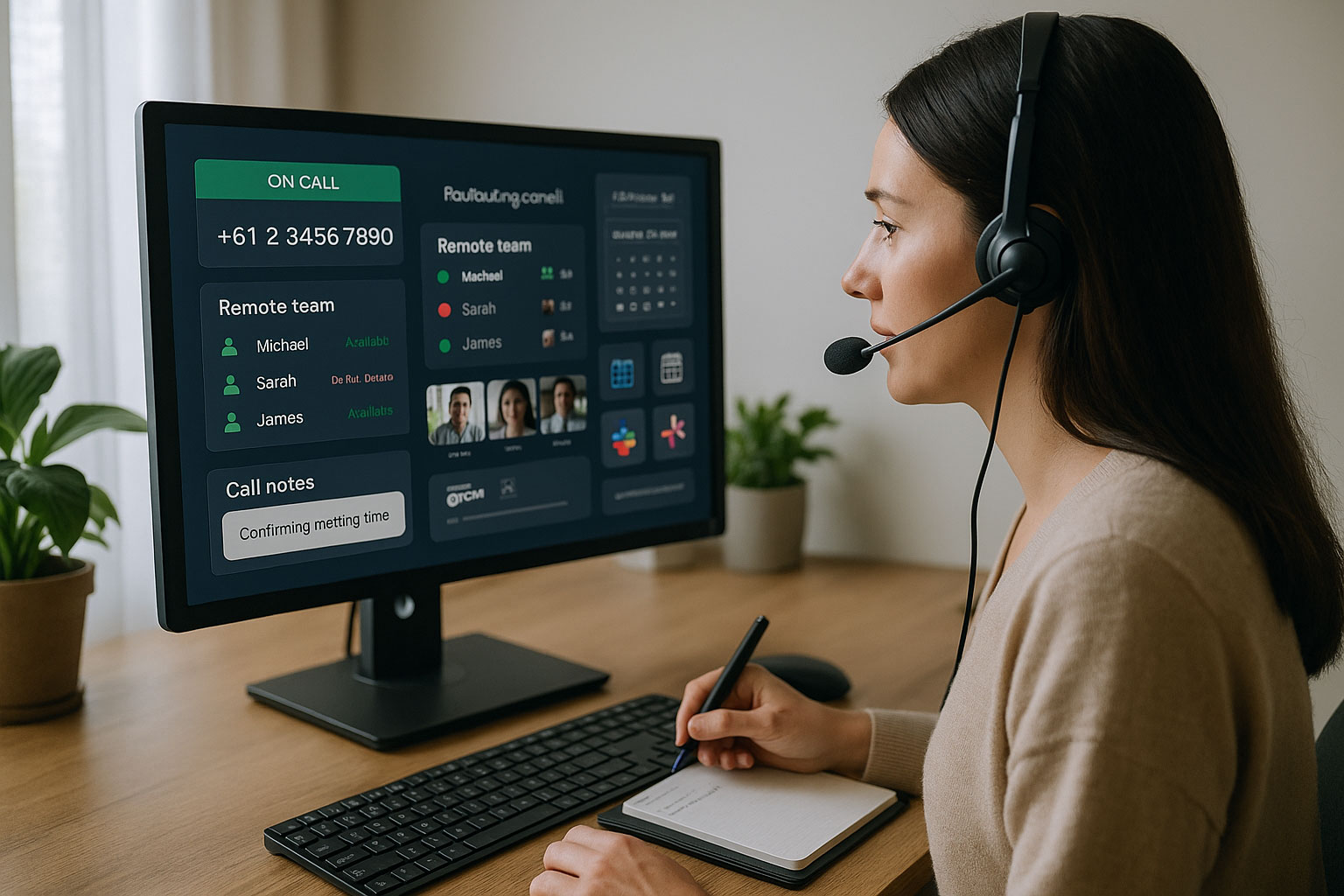
How Virtual Receptionists Support Remote and Hybrid Workforces
Remote and hybrid work have become the norm for many Australian businesses, changing how teams manage incoming calls and front-line enquiries. Staff are now split across homes, offices, and shared workspaces, making it impractical to rely on a single physical reception desk.
A virtual receptionist provides a consistent first point of contact for customers, regardless of the team’s location. By using trained receptionists who work remotely, organisations can maintain a professional image, keep call handling centralised, and ensure no enquiry is missed, even when the workforce is spread across multiple locations.
Scope and Boundaries of Virtual Reception
A virtual receptionist mirrors many of the responsibilities of an in-house receptionist, but operates entirely online. They answer inbound calls, manage the internal switchboard, schedule appointments, and take accurate messages. The role can also include simple triage to determine urgency, basic identity checks for secure transactions, processing payments in approved scenarios, and recording messages in the appropriate workflow. Unlike a full contact centre, the focus is on front-line interaction and routing, ensuring each caller reaches the right person or receives a clear next step without unnecessary transfers.
Onboarding Checklist (Before Go-Live)
A smooth start relies on capturing detailed information during setup. Key onboarding items include:
- Call types and their priority.
- Approved greetings, sign-offs, and restricted topics.
- Escalation paths and backup contact details.
- Hours of operation, public holiday cover, and on-call rosters.
- Verification steps, disclaimers, and compliance requirements.
This information ensures the service reflects the organisation’s brand and operational needs from day one, avoiding delays and miscommunication.
Presence-Aware Routing for Remote/Hybrid Teams
For distributed teams, routing calls accurately is a priority. Presence-aware systems check real-time availability from collaboration tools such as Microsoft Teams or Slack and calendar status indicators to determine who can take a call. If the preferred contact is unavailable, the system automatically routes the call to a backup or captures a message for quick follow-up. This keeps response times short, reduces caller frustration, and ensures no enquiry gets lost in a transfer loop.
After-Hours and Overflow Handling
Customers expect availability beyond traditional business hours. Virtual receptionists can manage this by forwarding urgent calls to on-call managers, recording messages for next-day follow-up, or scheduling call-backs for specific times. During seasonal peaks or unexpected surges, they can handle overflow traffic, reducing missed opportunities and maintaining consistent service levels even when demand spikes.
Integration Map
To be effective, a virtual receptionist must integrate with the systems the business already uses. Typical integrations include:
- Calendars (Google or Microsoft 365) for scheduling.
- CRMs for customer records.
- Ticketing platforms for support requests.
- VoIP/PBX systems for call routing.
- Shared inbox and live chat tools.
- Collaboration platforms such as Teams or Slack.
- Knowledge bases for accurate information retrieval.
These integrations keep call handling linked to the wider workflow, ensuring information flows seamlessly across the organisation.
Reliability and Failover
A dependable service must be built on redundancy. This could mean having multiple internet connections, backup phone lines, and power sources to prevent downtime. Voicemail capture rules ensure messages are recorded if systems fail, while Australian data residency options and retention policies safeguard sensitive information. Business continuity plans should be in place so operations continue smoothly, even if the primary platform is unavailable.
Security and Privacy in Australia
Virtual receptionists must handle sensitive information in compliance with local laws and regulations. Key measures include:
- Adhering to Australian Privacy Principles.
- Gaining call-recording consent in line with state requirements.
- Restricting access through least-privilege permissions.
- Using multi-factor authentication and secure VPN connections.
- Redacting sensitive details, such as payment information.
- Respecting the Do Not Call Register where applicable.
These safeguards protect customer data, maintain trust, and reduce regulatory risk.
Accessibility and Inclusion
An inclusive virtual receptionist service ensures all callers can communicate effectively. This can mean providing TTY/NRS support for people with hearing or speech needs, using plain-English scripts, offering language support for non-English speakers, and supplying pronunciation guides for staff to get names and locations right. It should also accommodate carers or authorised representatives where necessary.
Script Design and Tone
Scripts form the backbone of consistent call handling, but they must allow for natural conversation. Department-specific flows can help agents respond appropriately to different types of calls, while empathy cues support sensitive interactions. Fast paths for simple enquiries and well-crafted IVR prompts can save time, reducing caller effort and improving satisfaction.
Escalation Matrices and Response Times
Clear escalation protocols ensure that urgent matters are prioritised. This includes setting call-back time limits, designating backup contacts, and specifying what happens if the first contact is unreachable. For example, a critical service outage might have a five-minute escalation window, while general enquiries could be scheduled for next-business-day follow-up.
Targets and Reporting
Performance should be measured against agreed benchmarks. Metrics might include time to answer, transfer accuracy, missed call rate, call-back success rates, and first-call resolution where relevant. Weekly summaries can highlight trends, and comparing before-and-after results in the first 30–60 days provides evidence of value.
Quality Assurance and Calibration
Ongoing monitoring keeps service standards high. This could involve scheduled call listening, calibration sessions with the client, and using sector-specific QA scorecards. Attention should be paid not only to the accuracy of data capture but also to tone and brand alignment.
Knowledge Upkeep
As products, services, and policies evolve, call-handling materials must stay current. Updates to scripts, escalation procedures, and FAQs should follow an agreed review cycle, with changes approved and communicated to all receptionists before they go live.
Pricing and Cost Drivers
Pricing can be based on per-minute rates, per-call charges, or bundled hours. Costs are influenced by call complexity, integration needs, coverage hours, language requirements, and compliance obligations. While tailored services may carry higher initial costs, they often reduce inefficiencies and improve customer satisfaction.
Risk and Common Pitfalls
Common issues include misrouted calls, double handling, outdated scripts, and unclear escalation ownership. Preventing these requires regular reviews, clear documentation, and responsive training to address problems early.
Scenario Walkthroughs
Professional services: A caller requests a consultation; the receptionist verifies details, books the slot, and sends a confirmation email.
E-commerce: A customer wants to track an order; the receptionist checks the CRM, provides the status, and confirms delivery expectations.
Healthcare: A patient calls for an urgent appointment; the receptionist verifies ID, notes symptoms, and escalates to the nurse on call.
Real estate: A buyer enquires about a property; the receptionist provides details and books an inspection with the agent.
Choosing the Right Provider
Pick a partner that already supports distributed teams and can prove it. Ask for examples of similar setups, including how routing worked across time zones and how calendars, CRMs, and voice platforms connected. Request a clear plan for knowledge capture and sign‑off before launch. Check security controls, training plans, and the cadence for QA. Reporting samples matter. You want to see the exact metrics you will receive each week and how issues are raised and resolved. Flexibility on hours and overflow cover is a strong sign they can scale with you.
Measuring Ongoing Impact
Initial improvements are only part of the picture. Keep tracking results as routines change and campaigns come and go. Pair weekly summaries with a monthly review that blends numbers and a small call sample. Look for trends in missed call rate, transfer accuracy, time to answer, and call-back success. Run a simple quarterly “before vs after” comparison on one or two high-value lines, then adjust scripts or routing rules where small gains are still available. Share quick wins with staff so everyone understands what changed and why.
FAQ’s
Q1: Can a virtual receptionist handle both internal and external calls?
A1: Yes, they can manage customer calls and coordinate internal messages and transfers between team members.
Q2: How are calls routed to remote staff without delays?
A2: Presence-aware routing uses real-time availability from collaboration tools and calendars to direct calls to available team members.
Q3: Is it secure for them to access our systems remotely?
A3: Yes, provided security measures such as encryption, multi-factor authentication, and role-based permissions are in place.
Q4: Can they manage calls across different time zones?
A4: Many providers can schedule coverage and routing to suit teams working across multiple regions.
Q5: How quickly can the service be set up?
A5: With clear requirements, most services can go live within one to two weeks, depending on integration needs.



